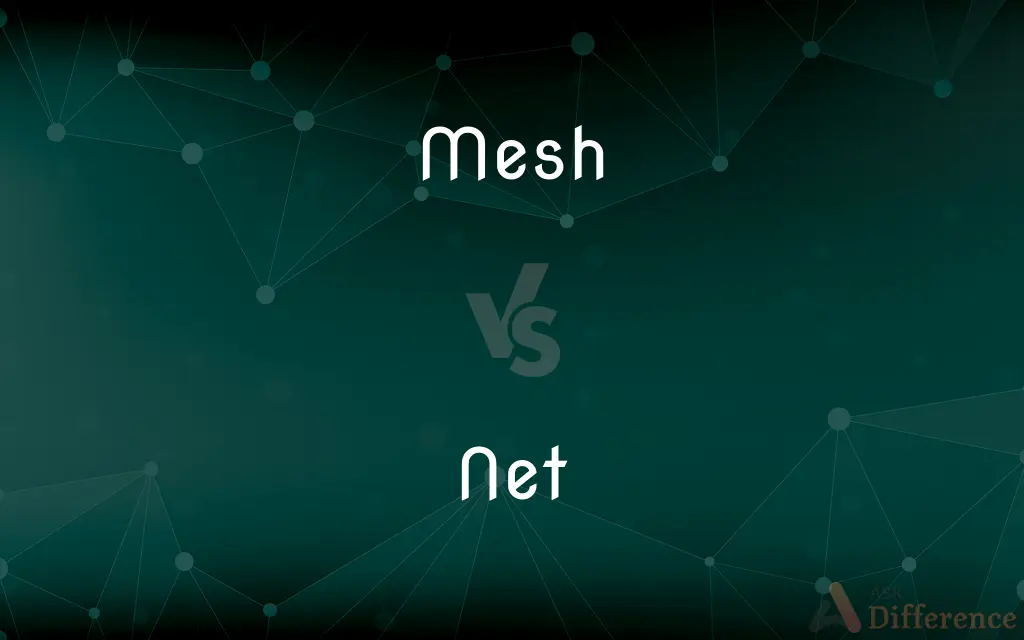Mesh vs. Net — What's the Difference?
By Fiza Rafique & Urooj Arif — Updated on February 24, 2024
Mesh is a fine material with closely spaced holes, often used in clothing or screens, while a net is a looser, larger grid-like fabric for catching or carrying items.

Difference Between Mesh and Net
Table of Contents
ADVERTISEMENT
Key Differences
Mesh is characterized by its closely knit structure, which makes it ideal for applications requiring a semi-transparent barrier. It's often found in applications ranging from clothing ventilation to filtration systems. Net features a more open and larger grid-like configuration, designed primarily for catching or holding items. Its structure is key to its functionality, whether it's in sports equipment like soccer goals, fishing nets, or cargo nets.
The material used in mesh can range from synthetic fibers to metal, affecting its durability, flexibility, and area of use. This variability allows mesh to be tailored for specific needs, from insect screens to high-strength industrial filters. The choice of material impacts its resistance to environmental factors and its suitability for either outdoor or indoor use.
Nets are often made from materials such as nylon, polyethylene, or rope, prioritizing strength and resistance to tearing. These materials ensure that nets can withstand the weight and force applied during their use, such as in sports or fishing. The durability and maintenance of a net depend significantly on its material and construction quality. Mesh's fine structure lends itself well to applications requiring precision and subtlety, such as in the medical field for surgical meshes or in consumer electronics for speaker grilles. Its ability to blend functionality with aesthetics makes it a popular choice in design-oriented applications.
Net's application leans more towards practicality and utility, with its use in safety equipment, like safety nets for construction, highlighting its role in protection and containment. Its straightforward design and functionality underscore its importance in various industries, from agriculture to sports.
The size of the openings within a net is crucial for its intended purpose, allowing for the passage of air and water while capturing or securing larger objects. The tightness of the weave or knit defines its effectiveness in different applications, emphasizing its versatility in controlling airflow and containing fine particles.
ADVERTISEMENT
Comparison Chart
Structure
Closely knit or woven, fine openings
Open, larger grid-like configuration
Material
Synthetic fibers, metal, etc.
Nylon, polyethylene, rope, etc.
Use
Filtration, clothing, screens
Catching, carrying, safety
Durability
Varies by material; often weather-resistant
Strong, tear-resistant
Application
Design-oriented, precision tasks
Practical, utility-focused tasks
Compare with Definitions
Mesh
A barrier or filter made from a mesh material;
A fine fabric with small, closely spaced holes;
Net
A safety device to catch falling objects or people;
Construction sites often have safety nets to protect workers.
Mesh
A mesh is a barrier made of connected strands of metal, fiber, or other flexible or ductile materials. A mesh is similar to a web or a net in that it has many attached or woven strands.
Net
A tool for carrying or containing items;
I brought a net bag to carry my groceries.
Mesh
The opening or space inclosed by the threads of a net between knot and knot, or the threads inclosing such a space; network; a net.
A golden mesh to entrap the hearts of men.
Net
To hit (the ball) into the net, as in volleyball.
Mesh
To catch in a mesh.
Net
To inclose or cover with a net; as, to net a tree.
Mesh
An open fabric of string or rope or wire woven together at regular intervals
Net
A trap made of netting to catch fish or birds or insects
Mesh
The act of interlocking or meshing;
An interlocking of arms by the police held the crowd in check
Net
Catch with a net;
Net a fish
Mesh
The mesh of streets in the old town can be confusing.
The mesh on the window screen prevents bugs from entering.
Net
A framework of intersecting lines or cables;
The net of ropes was used to secure the cargo.
Mesh
The mesh in the coffee filter keeps grounds out of your drink.
The mesh lining in my jacket keeps me cool.
Net
A barrier against flying insects.
Mesh
A network of interconnected metal or synthetic fibers;
A structure used in medical applications;
Net
To catch or ensnare in a net
Net fish.
Mesh
An interlaced structure resembling a mesh;
Surgical mesh is used to provide support for weakened tissues.
Net
To shoot (the ball or puck) into the goal, as in soccer or hockey.
Net
A fabric of twine, thread, or the like, wrought or woven into meshes, and used for catching fish, birds, butterflies, etc.
Net
Anything wrought or woven in meshes; as, a net for the hair; a mosquito net; a tennis net.
Net
A fabric made from interlaced threads with large spaces between;
We used a net to catch fish during our trip.
Net
Equipment made of netting used in sports;
The soccer ball flew straight into the net.
Common Curiosities
Are mesh and net used interchangeably?
In casual conversation, sometimes, but they have distinct purposes in technical contexts.
Which is stronger, mesh or net?
Strength depends on material and construction, not necessarily the type (mesh or net).
Can both mesh and net be used in clothing?
Yes, but mesh is typically used for ventilation or design, while net might be used for aesthetic overlays or functional components like pockets.
How do maintenance requirements differ for mesh and net?
Maintenance varies with material and use, but nets may require more frequent checks for tears or damage due to their load-bearing roles.
Can mesh and net materials be the same?
Yes, both can be made from similar materials, but the structure and end use often differ.
Are mesh or net materials more expensive?
Costs vary widely based on material quality and specific application needs.
What's the main difference between mesh and net?
Mesh is a finer fabric for filtering or ventilation, while net has larger openings for catching or carrying.
Are there environmental considerations in choosing between mesh and net?
Yes, material choice and durability can impact environmental suitability and sustainability.
Do mesh and net serve purposes in sports?
Yes, mesh is used in clothing and equipment for breathability, while nets are used in goals and protective barriers.
Is there a trend in using mesh or net in fashion?
Both are trendy for different reasons; mesh for sporty, breathable designs and net for decorative, textural elements.
How do environmental factors affect mesh and net longevity?
UV exposure, moisture, and mechanical wear can degrade materials, with some more resistant than others.
Is mesh always finer than net?
Typically, yes, mesh has finer openings than net.
Can both mesh and net be used outdoors?
Yes, but the material and construction must be suitable for weather conditions.
How does the application of mesh and net differ in architecture?
Mesh is used for aesthetic facades and light filtration, while netting can provide safety barriers or support climbing plants.
Can mesh be used for safety purposes?
Yes, in applications like surgical meshes or fine safety barriers, but not for heavy-duty protection like fall arrest.
Share Your Discovery

Previous Comparison
Receival vs. Reception
Next Comparison
Scene vs. SceneryAuthor Spotlight
Written by
Fiza RafiqueFiza Rafique is a skilled content writer at AskDifference.com, where she meticulously refines and enhances written pieces. Drawing from her vast editorial expertise, Fiza ensures clarity, accuracy, and precision in every article. Passionate about language, she continually seeks to elevate the quality of content for readers worldwide.
Co-written by
Urooj ArifUrooj is a skilled content writer at Ask Difference, known for her exceptional ability to simplify complex topics into engaging and informative content. With a passion for research and a flair for clear, concise writing, she consistently delivers articles that resonate with our diverse audience.















































